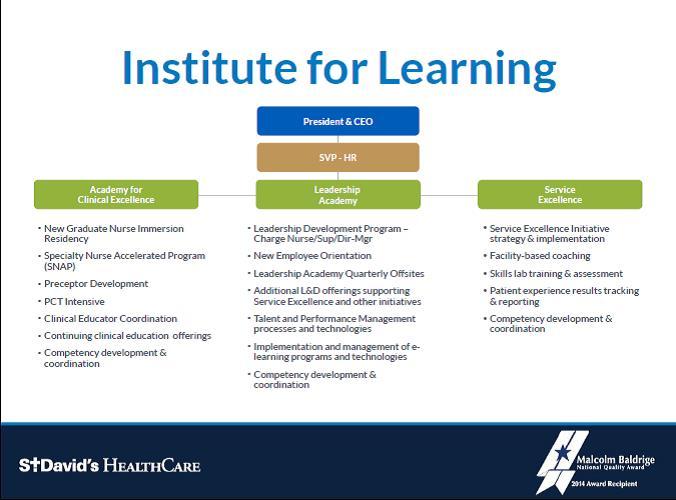Blogrige
The Official Baldrige Blog

Used with permission.
Health care organizations must have effective approaches to build and maintain a workforce with the skills to meet patients’ needs. Baldrige Award-winning St. David’s HealthCare Senior Vice President of Human Resources Richard Lowe outlined the St. David’s HealthCare system for ensuring a talented workforce during the Baldrige Program’s Quest for Excellence® conference last month.
The Austin, Texas-based health system employs more than 8,000 in its six hospitals, six ambulatory surgery centers, and numerous physicians’ practices. The organization has structured its human resources (HR) function through “centers of expertise” that manage workforce recruitment, compensation and benefits, service excellence, and an institute for learning that supports employee development. In addition, said Lowe, HR support teams based at St. David’s HealthCare facilities focus on ambulatory surgery and physician service lines.
The organization’s strategic planning process drives the HR strategy, with key metrics such as workforce productivity, turnover, and engagement identified and tracked. HR objectives, which are established as part of annual strategic planning process, are tightly aligned with overall business objectives, said Lowe. Those objectives are also anchored in the organization’s “ICARE” values of integrity, compassion, accountability, respect, and excellence. “It’s very important from a systems perspective to have alignment across our system,” he said. Therefore, the organization has standardized approaches to workforce policies, compensation and benefits, recruitment, performance management, and learning and organizational development.
For example, St. David’s Institute for Learning provides a centralized and standardized means to enhance the ICARE-based culture throughout the organization. Centralized offerings in leadership and organizational development allow for standardization in areas such as the new-employee orientation process, leadership development, and general training for employees, while also providing flexibility to adapt to changing needs, said Lowe.
And the Academy for Clinical Excellence—with offerings such as the New Graduate Nurse Immersion Residency and the Specialty Nurse Accelerated Program (SNAP), as well as continuing clinical-education offerings and competency development and coordination—represents a way that St. David’s has grown its own approach to supporting high performance.
According to Lowe, his organization has worked hard with local communities to cultivate opportunities for mutual success. The health system’s outreach commitments include education partner relationships and active participation in local, state, and regional associations and coalitions that benefit community health and well-being.
For example, St. David’s collaboration with Texas State University resulted in the St. David’s School of Nursing. The program provides the health care organization with a “deeper pipeline” of new workforce members; it simultaneously benefits the university through increased enrollment and the local community through retention of graduates residing in the local area. St. David’s has also partnered with the nonprofit Goodwill to create workforce development programs, which it can tap for ancillary support, said Lowe.
With a focus on maintaining its ICARE culture, St. David’s ensures that its prospective workforce is introduced early to the organization’s five core values. In fact, Lowe said that reviewing and accepting those ICARE values takes place before individuals can even apply for jobs, to help ensure each new hire’s “fit” with the organization’s culture.
To the same end, “high-functioning employees” are asked to conduct peer interviews on review panels to screen job applicants for fit with the cultural values. “Infusion of talent is critical to our sustained success; it’s just as important that that new talent understand the importance of our values,” said Lowe.
When CEOs of the various St. David’s facilities review the ICARE values as part of new-employee orientation, he added, “They don’t just talk about the values; they talk about why they matter.”
For more information about the workforce-focused approaches of St. David’s HealthCare and other Baldrige Award recipients, see the organizations’ profiles and award application summaries on the Baldrige Program’s website.
And please comment below to share how other high-performing organizations you know get and grow employees for the benefit of the organization’s future, customers and other stakeholders in the community, and individuals’ careers too.
About the author
Related Posts
Comments
- Reply





